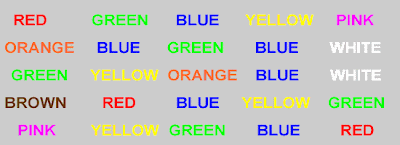
In order to be creative you need to break connections and make new ones. Our brains however like habits and routine and those paths are neurological hardwired and often difficult to break.
Below are a few exercises you can do to train your brain differently ![]()
According to Wikipedia, in psychology, the Stroop effect is a demonstration of interference in the reaction time of a task. When a word such as blue, green, red, etc. is printed in a color differing from the color expressed by the word’s semantic meaning (e.g. the word “red” printed in blue ink), a delay occurs in the processing of the word’s color, leading to slower test reaction times and an increase in mistakes. The effect is named after John Ridley Stroop who first published the effect in English in 1935.
Demonstration:
Say aloud the colors of each of these words, as fast as you can:

Now do it again:

If naming the first group of colors is easier and quicker than the second, then your performance exhibits the Stroop effect.
Why does this seem difficult?
The words themselves have a strong influence over your ability to say the color. The interference between the different information (what the words say and the color of the words) your brain receives causes a problem. There are two theories that may explain the Stroop effect:
- Speed of Processing Theory: the interference occurs because words are read faster than colors are named.
- Selective Attention Theory: the interference occurs because naming colors requires more attention than reading words.
Now do the Interactive JavaScript Demonstration of Stroop effect and see how neuropsychologically balanced you are.
Here are some cards to train yourself or test others.
Here are three new variations of the Stroop Effect:
Interactive DIRECTIONAL Stroop Effect Experiment
Interactive NUMBER Stroop Effect Experiment
Interactive ANIMAL Stroop Effect Experiment
The original reference to the Stroop paper is: Stroop, J.R. Studies of interference in serial verbal reactions. J. Exp. Psychol., 18:643-662, 1935. You can even read this complete 1935 paper on the web!

